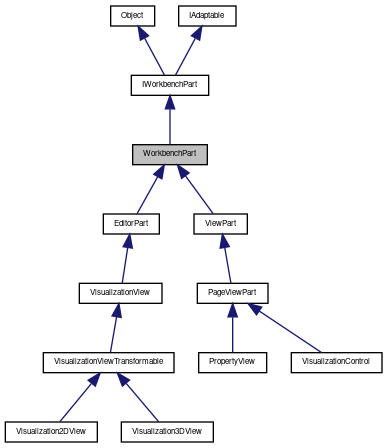A workbench part is a component within the workbench. More...
#include <rcp/WorkbenchPart.h>

Public Member Functions | |
| WorkbenchPart () | |
| template<typename Reflector > | |
| void | reflect (Reflector &r) |
| virtual void | activate () |
| Is called by the Workbench to inform the Part that is being activated by the user. More... | |
| virtual void | deactivate () |
| Is called by the Workbench to inform the Part that is being deactivated since another Part got the focus. More... | |
| bool | isActivated () const |
| Returns true if this ViewPart currently has the focus and hence the users attention. More... | |
| virtual void | init (IWorkbenchPartSite *site)=0 |
| Is called by the workbench. More... | |
| virtual Object * | getAdapter (const Class &adapter) |
| Returns an object which is an instance of the given class associated with this object. More... | |
| Class const & | getClass () const |
| call the virtual internalGetClass(). More... | |
Static Public Member Functions | |
| static PseudoClass const & | CLASS () |
Protected Member Functions | |
| virtual Class const & | internalGetClass () const =0 |
Detailed Description
A workbench part is a component within the workbench.
There are two main subclasses: ViewPart and EditorPart.
A view is typically used to display information or properties. Views are shown as dock windows. Only one instance of a particular view type may exist within the workbench. This policy is designed to simplify the view management for the user.
An editor is typically used to edit or browse data or objects. Editors are shown as tabbed MDI windows. In contrast to views there may exist multiple instances of a certain editor type.
Constructor & Destructor Documentation
◆ WorkbenchPart()
| WorkbenchPart | ( | ) |
Member Function Documentation
◆ reflect()
|
inline |
◆ activate()
|
virtual |
Is called by the Workbench to inform the Part that is being activated by the user.
Implements IWorkbenchPart.
Reimplemented in ViewPart.
◆ deactivate()
|
virtual |
Is called by the Workbench to inform the Part that is being deactivated since another Part got the focus.
Implements IWorkbenchPart.
Reimplemented in ViewPart.
◆ isActivated()
|
inline |
Returns true if this ViewPart currently has the focus and hence the users attention.
◆ init()
|
pure virtual |
Is called by the workbench.
The WorkbenchPart should initialize itself and my store the pointer tothe IWorkbenchPartSite interface for later use.
Implemented in EditorPart, and ViewPart.
◆ getAdapter()
Returns an object which is an instance of the given class associated with this object.
Returns nullptr if no such object can be found. The implementation if IAdaptable is responsible for destroying the instance of the created object.
Implements IAdaptable.
Reimplemented in VisualizationView.
◆ getClass()
|
inlineinherited |
call the virtual internalGetClass().
◆ CLASS()
|
inlinestaticinherited |
◆ internalGetClass()
|
protectedpure virtualinherited |
The documentation for this class was generated from the following file:
- gui/include/rcp/WorkbenchPart.h
 1.8.14
1.8.14